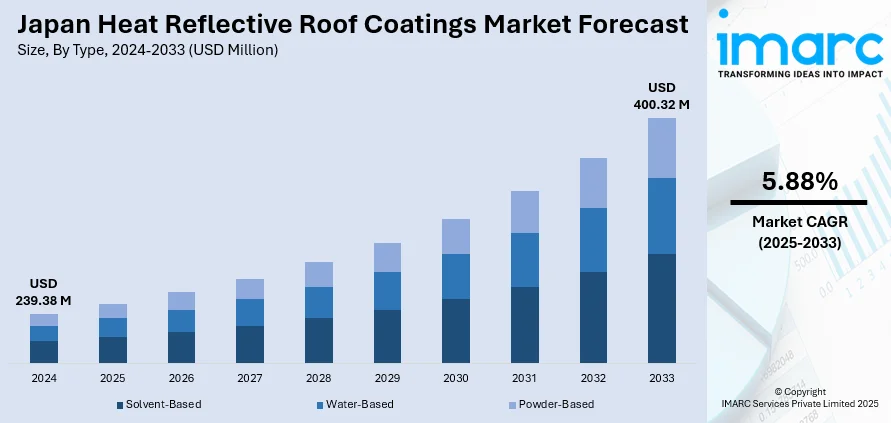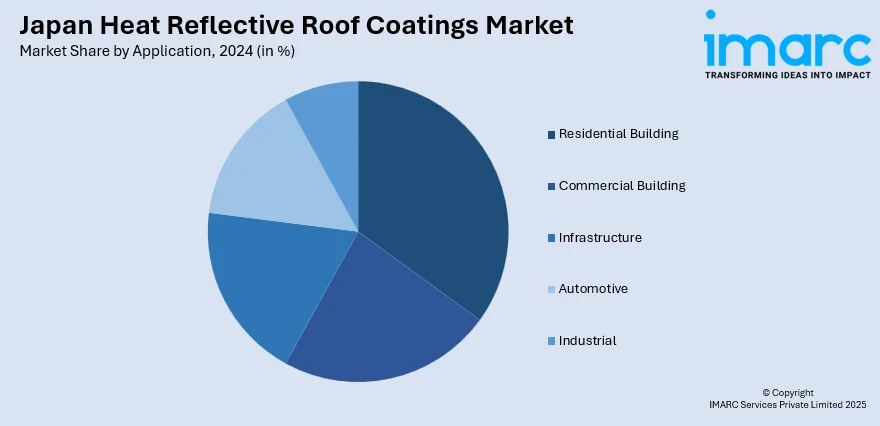
Japan Heat Reflective Roof Coatings Market Size, Share, Trends and Forecast by Type, Resin Type, Application, and Region, 2025-2033
Japan Heat Reflective Roof Coatings Market Overview:
The Japan heat reflective roof coatings market size reached USD 239.38 Million in 2024. Looking forward, IMARC Group expects the market to reach USD 400.32 Million by 2033, exhibiting a growth rate (CAGR) of 5.88% during 2025-2033. The market is propelled by emphasis on green urban planning, improvements in high-performance coating materials, and government energy policies encouraging building efficiency. These drivers raise adoption rates in residential, commercial, and public buildings, lowering energy demand while improving thermal comfort. Regulatory incentives and innovative materials further stimulate demand for heat reflective solutions, integrating them into Japan's environmental agenda. Together, these factors drive the growing Japan heat reflective roof coatings market share.
|
Report Attribute
|
Key Statistics
|
|---|---|
|
Base Year
|
2024
|
|
Forecast Years
|
2025-2033
|
|
Historical Years
|
2019-2024
|
| Market Size in 2024 | USD 239.38 Million |
| Market Forecast in 2033 | USD 400.32 Million |
| Market Growth Rate 2025-2033 | 5.88% |
Japan Heat Reflective Roof Coatings Market Trends:
Urban Sustainability and Smart Building Integration
Japan's focus on sustainable urbanization has given rise to greater adoption of heat reflective roof coatings for residential, commercial, and institutional buildings. With smart city initiatives growing in population centers such as Tokyo and Osaka, there is a strong preference for roofing systems that limit urban heat island effects. These coatings ensure indoor temperature regulation and reduce cooling energy use, in turn supporting Japan's long-term energy efficiency goals. Their compatibility with contemporary architectural structures further enables easy integration into new buildings as well as retrofitted facilities. These solutions have been especially embraced by public facilities and educational institutions to ensure greater thermal efficiency with environmental compliance. The increasing significance of climate-resilient infrastructure further enhances the call for novel roofing technologies. These forces combined drive the Japan heat reflective roof coatings market growth, solidifying the segment's importance in the nation's continual balancing of growth and environmental stewardship.

Coating Material and Performance Development
Technological advances in material science are driving high-performance heat reflective coating development in Japan. Research centers and industry are working on enhancing the solar reflectance and thermal emissivity of roof coatings to address changing environmental regulations. The advances made have led to coatings that are more durable, resilient to harsh weather conditions, and have longer service life. For example, in October 2024, MIRACOOLTM high reflective coating was introduced, reducing building surface temperatures by reflecting 92.2% solar radiation, cutting cooling costs up to 40%, and lowering indoor heat by up to 10°C. Furthermore, nano-enhanced and elastomeric coatings, for example, are becoming more prominent because they are better at deflecting infrared radiation and lowering roof surface temperatures. These products are highly used on commercial rooftops and industrial developments to reduce energy consumption and ensure operational efficiency. Spurring greater acceptance has also been the trend toward low-carbon building materials. Thus, the focus on performance-driving innovations is centrally responsible for propelling Japan heat reflective roof coatings expansion to make the market technologically driven and quality-oriented.
Government Energy Policies and Building Efficiency Programs
Japan's pledge to go carbon neutral and conserve energy has seen its government strongly promoting the use of heat reflective roof coatings. Policies at the national and state levels focus on enhancing building insulation efficiency and minimizing mechanical cooling dependence. Refurbishments, green certification, and reward programs have been implemented to encourage the use of reflective coating in both public and private construction. Building regulations increasingly specify or suggest energy-efficient materials, so construction companies and real estate developers make reflective solutions a priority when they plan. The policies are especially effective in disaster zones subject to rebuilding and hot climates, where efficiency at cooling is critical. Government facilities, schools, and public housing estates are common recipients of such programs. The inclusion of heat reflective solutions into policy has consequently been at the forefront of determining market direction and driving Japan heat reflective roof coatings expansion, underlining the material's position within domestic energy policy.
Japan Heat Reflective Roof Coatings Market Segmentation:
IMARC Group provides an analysis of the key trends in each segment of the market, along with forecasts at the country and regional levels for 2025-2033. Our report has categorized the market based on type, resin type, and application.
Type Insights:
- Solvent-Based
- Water-Based
- Powder-Based
The report has provided a detailed breakup and analysis of the market based on the type. This includes solvent-based, water-based, and powder-based.
Resin Type Insights:
- Epoxy
- Polyester
- Silicon
- Acrylic
A detailed breakup and analysis of the market based on the resin type have also been provided in the report. This includes epoxy, polyester, silicon, and acrylic.
Application Insights:

- Residential Building
- Commercial Building
- Infrastructure
- Automotive
- Industrial
The report has provided a detailed breakup and analysis of the market based on the application. This includes residential building, commercial building, infrastructure, automotive, and industrial.
Regional Insights:
- Kanto Region
- Kansai/Kinki Region
- Central/ Chubu Region
- Kyushu-Okinawa Region
- Tohoku Region
- Chugoku Region
- Hokkaido Region
- Shikoku Region
The report has also provided a comprehensive analysis of all the major regional markets, which include Kanto Region, Kansai/Kinki Region, Central/Chubu Region, Kyushu-Okinawa Region, Tohoku Region, Chugoku Region, Hokkaido Region, and Shikoku Region.
Competitive Landscape:
The market research report has also provided a comprehensive analysis of the competitive landscape. Competitive analysis such as market structure, key player positioning, top winning strategies, competitive dashboard, and company evaluation quadrant has been covered in the report. Also, detailed profiles of all major companies have been provided.
Japan Heat Reflective Roof Coatings Market Report Coverage:
| Report Features | Details |
|---|---|
| Base Year of the Analysis | 2024 |
| Historical Period | 2019-2024 |
| Forecast Period | 2025-2033 |
| Units | Million USD |
| Scope of the Report |
Exploration of Historical Trends and Market Outlook, Industry Catalysts and Challenges, Segment-Wise Historical and Future Market Assessment:
|
| Types Covered | Solvent-Based, Water-Based, Powder-Based |
| Resin Types Covered | Epoxy, Polyester, Silicon, Acrylic |
| Applications Covered | Residential Building, Commercial Building, Infrastructure, Automotive, Industrial |
| Regions Covered | Kanto Region, Kansai/Kinki Region, Central/Chubu Region, Kyushu-Okinawa Region, Tohoku Region, Chugoku Region, Hokkaido Region, Shikoku Region |
| Customization Scope | 10% Free Customization |
| Post-Sale Analyst Support | 10-12 Weeks |
| Delivery Format | PDF and Excel through Email (We can also provide the editable version of the report in PPT/Word format on special request) |
Key Questions Answered in This Report:
- How has the Japan heat reflective roof coatings market performed so far and how will it perform in the coming years?
- What is the breakup of the Japan heat reflective roof coatings market on the basis of type?
- What is the breakup of the Japan heat reflective roof coatings market on the basis of resin type?
- What is the breakup of the Japan heat reflective roof coatings market on the basis of application?
- What is the breakup of the Japan heat reflective roof coatings market on the basis of region?
- What are the various stages in the value chain of the Japan heat reflective roof coatings market?
- What are the key driving factors and challenges in the Japan heat reflective roof coatings?
- What is the structure of the Japan heat reflective roof coatings market and who are the key players?
- What is the degree of competition in the Japan heat reflective roof coatings market?
Key Benefits for Stakeholders:
- IMARC’s industry report offers a comprehensive quantitative analysis of various market segments, historical and current market trends, market forecasts, and dynamics of the Japan heat reflective roof coatings market from 2019-2033.
- The research report provides the latest information on the market drivers, challenges, and opportunities in the Japan heat reflective roof coatings market.
- Porter's five forces analysis assist stakeholders in assessing the impact of new entrants, competitive rivalry, supplier power, buyer power, and the threat of substitution. It helps stakeholders to analyze the level of competition within the Japan heat reflective roof coatings industry and its attractiveness.
- Competitive landscape allows stakeholders to understand their competitive environment and provides an insight into the current positions of key players in the market.
Need more help?
- Speak to our experienced analysts for insights on the current market scenarios.
- Include additional segments and countries to customize the report as per your requirement.
- Gain an unparalleled competitive advantage in your domain by understanding how to utilize the report and positively impacting your operations and revenue.
- For further assistance, please connect with our analysts.
 Request Customization
Request Customization
 Speak to an Analyst
Speak to an Analyst
 Request Brochure
Request Brochure
 Inquire Before Buying
Inquire Before Buying




.webp)




.webp)












